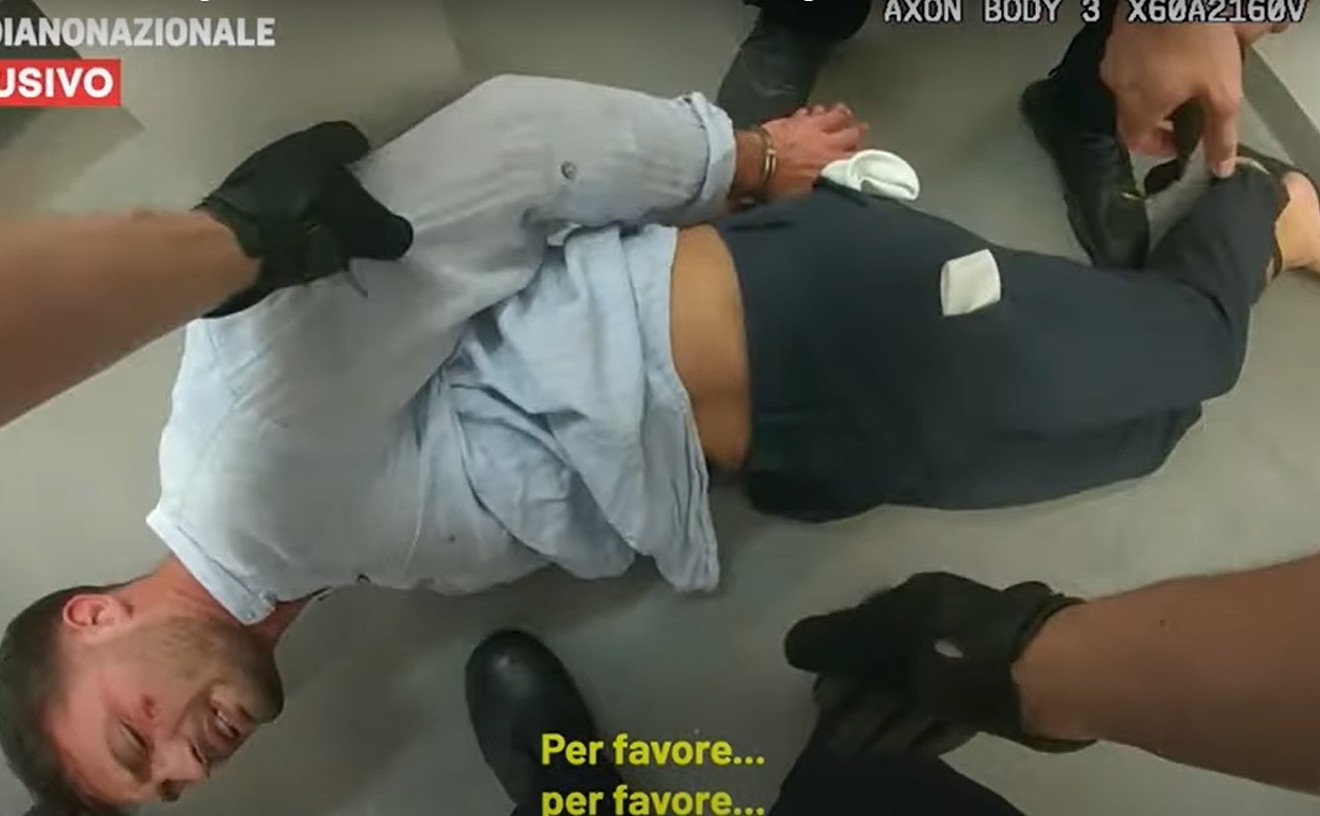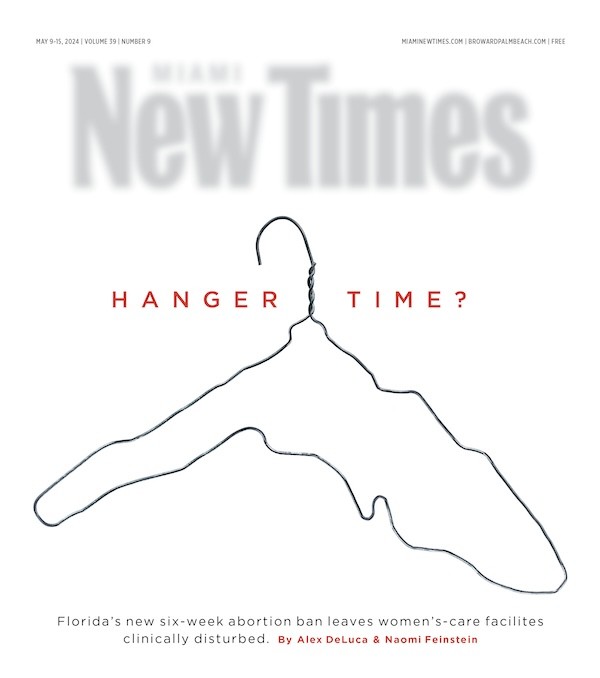That's why I decided to test every form of transit available on my short trip to the office — to add some firsthand evidence to the ongoing debate on how to make Miami a commuter-friendlier town. But first things first: I live in Edgewater, and I work in Wynwood. By Miami commuting standards, I've got it good. I know that people who truck from Kendall to downtown and back every day hate me.
Still, testing a short route has advantages in analyzing our city's problems. It's nonsensical, after all, to drive my car on a mile-long trip. I'm just adding to traffic congestion on key roads and getting in the way of people who have far longer commutes. Besides, if I can't find an efficient way to get to work using Miami's public transportation or other methods, what does that say for folks with tougher commutes?
Plus, the reality is that Edgewater is Miami's fastest-growing residential neighborhood, with towers popping up at lightning speed. Wynwood, meanwhile, is one of Miami's most rapidly developing commercial areas (and if developer Moishe Mana gets his way, one that will only grow larger). These should be two neighborhoods that are relatively easy to navigate for those without a car — yet that task is not as easy as I thought.
Before getting to each form of transit, I have an important point to make about traveling between Edgewater and Wynwood. Take a look at this map:
The area highlighted in blue is the Florida East Coast Railway (the future home of the Brightline route to Orlando), and all the roads in that area do not cross the rails. Remember New Times' "A Beginners Guide to Getting Around Miami," which noted that Miami's grid system usually makes sense and is almost easy to use? This is one of those annoying little kinks in the system. Getting from the heart of Edgewater to the heart of Wynwood isn't as simple as it seems. As those neighborhoods will continue to grow, urban planners will look at that rail line and just add a hashtag of "#SMDH" to their projects. The red dots on the map, meanwhile, are the only stoplights on NE Second Avenue and North Miami Avenue near that blue stretch.
Driving
Time: 8 minutes
Cost: About 10 cents of gas, at most
Summary: "Can you blame me?"
I get in my car. I drive. Some days, I might curse the fact that the intersection of NE 29th Street and North Miami Avenue (i.e., the intersection that basically divides Wynwood and midtown) is a mess because it lacks a turning lane, but the day I drive to work for this story, that isn't the case. I turn into Wynwood. A minute later, I'm in my parking spot in New Times' free designated lot. It's a pretty simple, attractive way to get to work, rain or shine. Some quick back-of-napkin math tells me I'm not spending more than 10 cents for gas. Who could blame me for getting to work this way if I owned a car? You'd probably do it too.
The biggest issue with driving this route is the trip home. After 5 p.m., workers from downtown clog the north-south avenues while traveling to the I-95 onramps. It makes for a rather stressful, traffic-filled, mile-long journey home and means I'm just adding congestion to traffic when I really shouldn't.
Walking
Time: 22 minutes
Cost: Free
Summary: "High chance of moisture."
I began walking to work somewhat regularly earlier this year when I found out my phone has a built-in pedometer. I have to get those 10,000 steps a day! I cross Biscayne Boulevard at a traffic light because I'm not insane and then head west to NE Second Avenue at NE 27th Street. That's where I jaywalk, because I'm a Miamian, and I do it again on North Miami Avenue, because by that time I'm a hardened criminal who has developed a taste for breaking the law. The problem, though, as you'll notice on the map above, is that those stretches of road are light on traffic lights, meaning many drivers speed through them like they're auditioning for Fast & Furious 8, because they too are Miamians. I pass no judgment.
The more obvious problem with this method of transit, though, is that unless the weather is cool and dry, there's a high chance that I show up to work a bit moist, either by rain or my own sweat. One day when I actually did walk up to NE 29th Street, I saw a fellow walker wearing khakis and dress shoes below the waist and absolutely nothing above it. A crisp white dress shirt was in one hand, a briefcase in another. It was vulgar and disgusting and against all social norms, yet I thought, I understand you, sir, and for practical reasons, I wish I had your confidence.
Trolley
Time: 27 minutes
Cost: Free
Summary: "Why is there no Wynwood stop?"
I love the trolley! I really do! Miami's cute little orange-and-green bus is great if I ever want to get to downtown without having to worry about parking. It's also free. The city's trolley app is great too, and it's pretty accurate when predicting arrival times. The day I test the trolley as a commuting method, I head out my door when the app tells me the trolley will arrive at the nearest stop in five minutes. It's on time — so far, so good. The obvious glitch in my plan is that the trolley doesn't stop in Wynwood. The farthest I can go is to NE 29th Street near midtown. So I get off, and the trolley continues into midtown and then the Design District before looping back. I walk into Wynwood, which doesn't save me much walking time at all. The affair ends up taking me longer than if I had simply walked the whole distance.
Which begs the question: Why is there no trolley service to Wynwood? Why doesn't the Biscayne route head into the neighborhood after hitting midtown instead of going into the Design District? Are there that many people taking free public transit to shop for Hermès purses? The Design District now has multiple giant parking garages. Wynwood remains a parking nightmare. Why one neighborhood gets trolley service and the other doesn't remains a mystery.
Metromover
Time: 45 minutes
Cost: Free
Summary: "I wanted to prove a point!"
This part of my plan sounded funny when I pitched it to my editors but was an absolute nightmare when I attempted it. As you may know, Metromover doesn't service either Edgewater or Wynwood. It's strictly a downtown and Brickell route with a tiny stretch into Omni. So in order to take Metromover to work, I hop onto a trolley and head south to the Omni station. I wait about five minutes, jump into a Metromover car, and exit exactly four blocks west. I am now a 1.4-mile walk from my office. Yes, a farther walk than if I had just strolled straight from home. And I arrive at the office absolutely disgusting. (A quick aside: Are office building locker rooms a feature of the Miami office building of the future or a creepy idea? I honestly can't decide.)
Why did I do this? I just want the universe to understand that I would like to see Metromover extended farther north. Will it ever happen? Probably not. Is it feasible or even possible? I have no idea. Would a northern extension assist me in my east-to-west commute? No, it wouldn't, but it could help others, and now the idea is out there.
Citi Bike
Time: 12 minutes
Cost: $4
Summary: "Fear is ignorance"
On a scale of 1 (comfortable aggressively biking among cars on Biscayne Boulevard) to 10 (has nightmares about riding a bike anywhere in Miami-Dade County), I used to be a solid 8. I know — I'm not a bike person. However, when Miami Beach introduced what was then called DecoBike, it allowed me to get comfortable with riding a bike in an urban area without committing to bike ownership. Citi Bike's expansion into Miami has furthered my experimentation. I once even rode over the Venetian Causeway before it closed for repairs (and it suffices to say I don't plan to bike over the MacArthur Causeway anytime soon). Yet despite one station being about two blocks from my apartment and another located right in front of New Times HQ, I had never taken the bike share to work before this experiment.
The day I try it, I'm embarrassed that the idea once scared me. I travel the same route as when I walk (including waiting for a crosswalk signal at Biscayne, because I'm still a bit of a bike baby), and it takes me about half the time. Of course, Citi Bikes aren't the most comfortable biking option, but it isn't a big deal given the short trip.
The $4 price seems a little expensive considering Uber wouldn't have cost me much more, but then again, I could get a pass with unlimited free trips up to 30 minutes for $15. I've been considering it ever since, but I still haven't taken the plunge.
Uber
Time: 9 minutes
Cost: $4.70
Summary: "Nice if you've got the money."
Though I always request UberX, the lower-cost Uber option, the past two out of the three times I've used the service, a standard-class car has picked me up. So three minutes after I request a ride, a white Mercedes E-Class shows up outside my apartment, and I'm off. Uber cars have a reputation for being cleaner than taxis, but there's some sand on the floor mats this day. As a South Floridian, I understand. It's a pretty quick ride, and nine minutes after I opened the app, I'm at the office. The downside, though, to using the service for such short rides is that you end up having to pay the $4.70 minimum fare no matter how quick the route. That's still a bit cheaper than the $5 minimum for Lyft rides but is still expensive for a daily transit option. In fact, if I were to hitch an Uber ride to work and back every day, it would cost me $2,200 a year.
ZabCab
Time: 14 minutes
Cost: $8.05 + $2.05 tip
Summary: "This won't save the cab industry."
This is the app that was introduced to Miami during a big to-do at Pérez Art Museum Miami in September. It's supposed to make ordering a traditional cab as easy as calling Uber or Lyft. It does. Sort of. Except it doesn't do much more.
I've never used the app, so I download it only 15 minutes before I leave for work. Setting up an account is relatively easy and doesn't even require your last name (but a phone number and email address are required). The app advertises that, like Uber or Lyft, you can track your cab as it comes to you. However, when I request one, the app tells me that my cab will arrive in "calculating..." After three minutes of this stalling, I get nervous and am not sure it's working. ZabCab gives you the option to call your driver, though. So I do. Turns out he's 30 seconds away.
The car shows up, and I notice it has decals advertising not ZabCab but Way2Ride, the other taxi app used by some local drivers. Whatever. It's a cab, much like any other. My drive is perfectly nice and doesn't take any longer than the Uber ride. The difference in time is the wait.
The big difference between this app and Uber is price and payment method. You can request a cab that accepts credit cards, but you can't pay through the app. The price, with tip, also ends up being more than twice the price of
The app is a step in the right direction for the traditional cab industry, but it certainly won't save it. Perhaps the only way this ZabCab comes in handy is when Uber's surge prices are out of control.
Metrobus
Time: N/A
Cost: N/A
Summary: "Everyone hates the bus."
I key my starting point and destination into the Metrobus trip planner website.
It tells me to walk. So I do. Yes, technically, if I really wanted to take a bus to work, I could have hopped onto one to downtown on Biscayne and then taken another up NW Second Avenue, but a man can endure only so much pain to get to work.
What I Learned
Wynwood and Edgewater are the two neighborhoods that have been most transformed by the latest building boom — yet the city's transit options for getting between them are hilariously inept. Of all the methods of transit I tried, Citi Bike was the only one I found to be a practical option.
Truth be told, though, I'd grown quite fond of walking before I even began the experiment. In fact, studies have shown that walking to work is the least stressful method of commuting, plus it's the best health-wise. (In fact, I'm now walking to work in pants that didn't fit a few months ago.) However, it's not an option for many Miamians. It's not even much of an option for Miamians who may live close to their workplace but have to show up in a suit — or even just presentable and sweat-stain-free. Walking in this town also requires checking the weather report and having an umbrella just in case that report is dead wrong.
So I can certainly see why so many people who have short commutes continue to drive. Then again, if we can't get people who drive only a few miles to work weaned off their cars, how will we ever persuade people who have real commutes?











